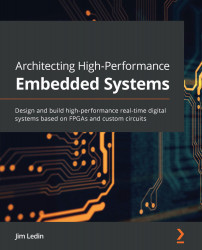Architecting High-Performance Embedded Systems: A Comprehensive Guide
1. Introduction
In today's rapidly evolving technological landscape, embedded systems are ubiquitous, powering everything from smartphones and wearables to industrial automation and autonomous vehicles. Designing these systems demands a deep understanding of hardware, software, and real-time constraints. This white paper explores critical aspects of architecting high-performance embedded systems, drawing inspiration from the concepts presented in "Architecting High-Performance Embedded Systems" by Packt Publishing.
2. Core Principles
- Real-Time Constraints: Understanding and meeting stringent timing requirements is paramount. This involves:
- Real-Time Operating Systems (RTOS): Selecting and utilizing suitable RTOS kernels (e.g., FreeRTOS, Zephyr) to manage tasks, prioritize execution, and ensure timely responses.
- Interrupt Handling: Efficiently handling interrupts to minimize latency and ensure timely responses to external events.
- Timing Analysis: Performing rigorous timing analysis to ensure that all deadlines are met.
- Power Efficiency: Designing systems that consume minimal power is critical, especially for battery-powered devices.
- Resource Optimization: Efficiently utilizing hardware resources (CPU, memory, peripherals) to maximize performance and minimize costs.
- Reliability and Fault Tolerance: Designing systems that are robust and can withstand failures, ensuring continued operation even in the face of unexpected events.
- Security: Implementing security measures to protect embedded systems from cyberattacks and unauthorized access.
3. Key Architectural Considerations
- Hardware Selection: Choosing the appropriate processor (microcontroller, microprocessor, DSP, FPGA) based on performance requirements, power consumption, cost, and availability.
- Peripheral Selection: Selecting and integrating appropriate peripheral devices (sensors, actuators, communication interfaces) to meet system requirements.
- Software Design:
- Modular design: Breaking down complex systems into smaller, manageable modules.
- Object-oriented programming: Utilizing OOP principles for code reusability, maintainability, and flexibility.
- Asynchronous programming: Utilizing asynchronous programming techniques to improve responsiveness and concurrency.
- Testing and Verification: Rigorous testing at all stages of the development process, including unit testing, integration testing, and system-level testing.
4. Use Cases
- Industrial Automation: Designing high-performance control systems for manufacturing, robotics, and process automation.
- Internet of Things (IoT): Developing intelligent devices for smart homes, smart cities, and industrial IoT applications.
- Automotive: Designing embedded systems for advanced driver-assistance systems (ADAS), autonomous vehicles, and infotainment systems.
- Aerospace and Defense: Developing flight control systems, guidance systems, and other critical systems for aerospace applications.
- Medical Devices: Designing embedded systems for medical devices such as pacemakers, ventilators, and imaging systems.
5. Tools and Technologies
- Embedded Systems Development Tools: IDEs (e.g., Eclipse, Keil), debuggers, emulators, and other development tools.
- Real-Time Operating Systems (RTOS): FreeRTOS, Zephyr, QNX, VxWorks.
- Hardware Description Languages (HDLs): VHDL and Verilog for designing FPGAs.
- Communication Protocols: CAN, I2C, SPI, UART, Ethernet.
- Debugging and Analysis Tools: Logic analyzers, oscilloscopes, and other tools for debugging and analyzing system behavior.
6. Joomla SEO
Keywords:
- Embedded Systems
- High-Performance Embedded Systems
- Real-Time Systems
- Embedded Systems Design
- RTOS
- FPGA
- IoT
- Industrial Automation
- Automotive
- Aerospace
- Medical Devices
- Embedded Systems Development Tools
7. Conclusion
Architecting high-performance embedded systems requires a multidisciplinary approach that combines hardware and software expertise, a deep understanding of real-time systems, and a focus on reliability and efficiency. By adhering to the principles outlined in this white paper and leveraging the latest tools and technologies, engineers can design and develop cutting-edge embedded systems that drive innovation in various industries.
8. References
- "Architecting High-Performance Embedded Systems" by Packt Publishing
- "Embedded Systems: Architecture, Programming, and Design" by Raj Kamal
- "Real-Time Systems: Concepts, Design, and Analysis" by Jane W. S. Liu
- "Designing Embedded Systems" by Elecia White
Disclaimer: This white paper provides a general overview of the key concepts and considerations in architecting high-performance embedded systems. The specific requirements and design choices will vary depending on the specific application and constraints.
This information is for general knowledge and informational purposes only.



